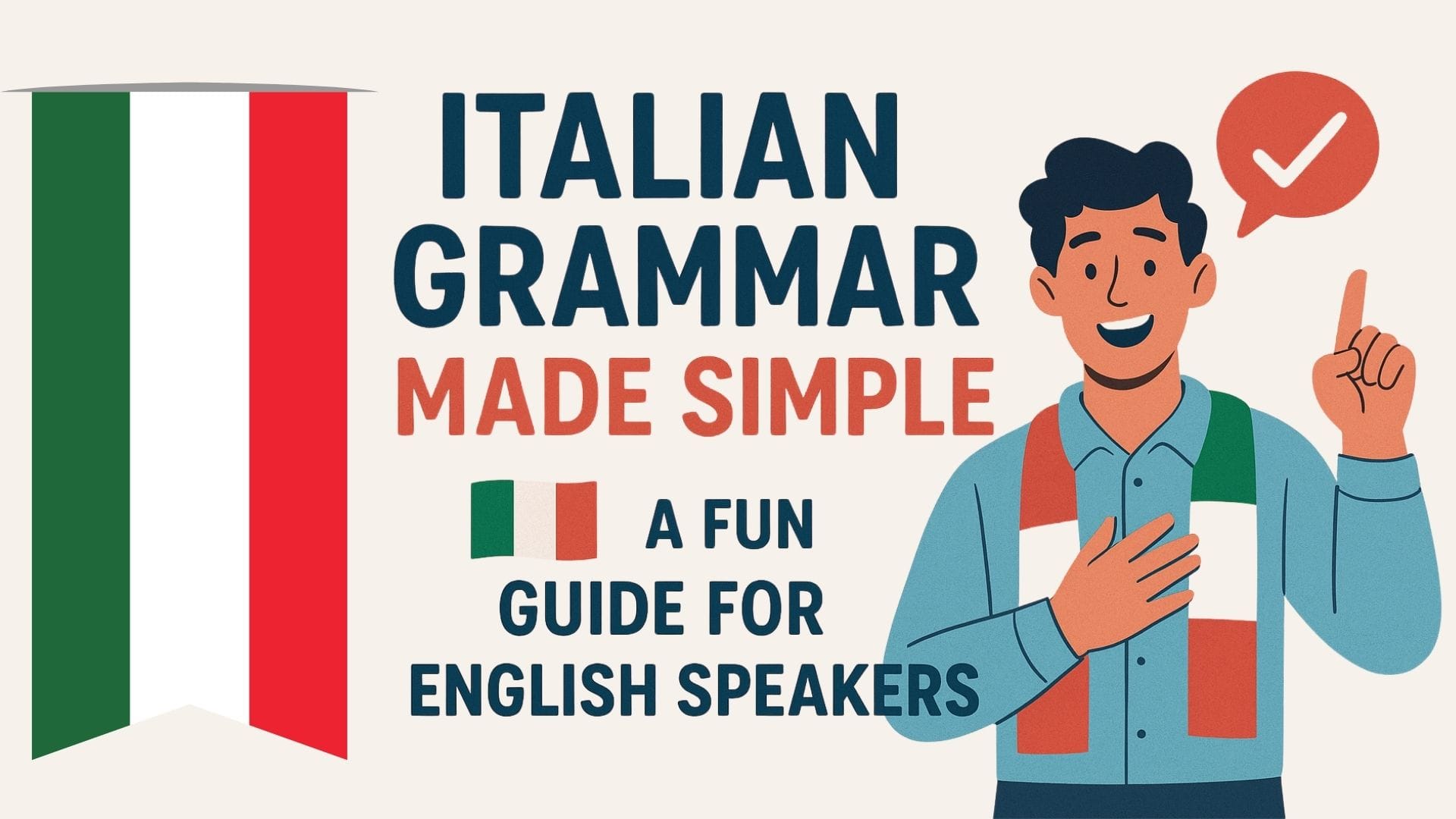At The Italian Lesson, we often hear new students say: “Italian grammar is too hard!” But the truth is: it’s not. Italian grammar is not a maze of impossible rules — it’s more like a friendly user manual that helps you navigate the language and communicate with confidence.
And here’s the best part: grammar doesn’t have to be boring. With the right approach, it can even be fun. Let’s explore why Italian grammar isn’t difficult, how we turn rules into games, and why it’s your best ally if you’re learning Italian as an English speaker.
Table of Contents
1. Why Studying Italian Grammar Helps You
Grammar is often seen as a barrier, but in reality it’s a map. Without it, you might know a few words but not how to put them together. With it, you unlock entire conversations.
A study from the European Commission revealed that every year more than 2 million students from 115 countries choose Italian language courses. For most of them, grammar provides the foundation for fluency.
As the linguist Anne Curzan points out, grammar is not about memorizing dusty rules but about understanding patterns that make communication smoother and clearer.
In other words: grammar is not the destination — it’s the GPS that takes you there.
2. Is Italian Grammar Difficult? Let’s Bust the Myth
The myth that Italian grammar is “too hard” is widespread, especially among English speakers. But data says otherwise.
According to the Foreign Service Institute (FSI), Italian belongs to Category I languages, which are the easiest for native English speakers to learn. They estimate that it takes 24–30 weeks (600–750 hours) to reach working proficiency — far less than languages like Arabic, Chinese, or Japanese.
Why? Because Italian grammar rules are often consistent and logical. For example:
- Plural endings (-o → -i, -a → -e) are far more predictable than English plurals.
- Pronunciation matches spelling: no silent letters maze like “through” or “knight.”
- Verb conjugations follow patterns, and even irregular verbs have recognizable logic.
So, is Italian grammar difficult? Not at all. It’s actually more straightforward than many expect.
3. Tips for Learning Italian Grammar Without Stress
At The Italian Lesson, we’ve learned that grammar sticks better when students are engaged and laughing. Here are some of our proven methods:
- Context first: Instead of isolated drills, we insert grammar into real situations — ordering coffee, buying a bus ticket, introducing yourself.
- Grammar games: We often turn conjugations into timed challenges or team games. One class had 60 seconds to make as many sentences as possible with the subjunctive — the result was laughter, mistakes, and, surprisingly, great learning.
- Error-friendly learning: We celebrate mistakes. Each error becomes a mini-game: “How can we fix this and make it funny?”
- Micro-reviews: At the end of every lesson, we review key points with quick-fire questions so grammar doesn’t fade away.
These tips for learning Italian grammar make it feel less like studying and more like playing.
4. Real Stories From Our Lessons
Here’s how we’ve made grammar come alive with our students:
- The Italian Market Roleplay (A2 level): Students practiced articles, demonstratives, and numbers by “shopping” at a pretend market. Grammar was embedded in every purchase.
- The Subjunctive Challenge (B1/B2 level): For five minutes, students had to speak only using the subjunctive. Each mistake meant a playful penalty. The competitive spirit helped them memorize tricky forms.
- The Story Chain (Advanced level): Students created a collective story, but each sentence had to include a relative pronoun or adverb. The stories turned hilarious — and so did the grammar practice.
In all these cases, Italian grammar lessons online became lively, interactive, and memorable.
5. Where to Study Italian Grammar
When searching for Italian grammar online, you’ll find countless resources. Here’s what works best:
- Group lessons with native teachers: Like ours at The Italian Lesson — small groups, maximum interaction.
- Structured video courses: Self-paced learning with clear explanations, downloadable material, and quizzes.
- Interactive blogs & podcasts: Extra content to review grammar in a fun way.
- Online communities: Great for support, but be careful with unreliable advice.
Our platform combines all of these: live lessons, recorded courses, and free resources.
6. Q&A: Italian Grammar Myths Answered
Q: What’s included in Italian basic grammar?
A: Articles, nouns, adjectives, regular verb conjugations, personal pronouns, and prepositions. Advanced topics include subjunctive, conditional, and passive voice.
Q: Is Italian grammar full of exceptions?
A: Far fewer than English! Most rules are logical and consistent.
Q: How long does it take to master grammar?
A: The FSI estimates 24–30 weeks. With consistent practice, students notice real progress after 3–4 months.
Q: Can I learn grammar without a teacher?
A: You can learn the basics, but without feedback you risk fossilizing mistakes. That’s why Italian grammar lessons online with native teachers are so effective.
Q: Why do grammar rules sometimes feel arbitrary?
A: Because languages evolve socially. Grammar reflects habits, not laws of nature. As linguist Anne Curzan notes, rules often emerge from usage.
7. Our Approach: Grammar as a Tool, Not the Goal
At The Italian Lesson, grammar is:
- Supportive, not central — communication comes first.
- Playful — we turn rules into games and stories.
- Flexible — adapted to each student’s pace and goals.
- Human — mistakes are part of the process, and humor is essential.
That’s why our Italian grammar for English students feels approachable, useful, and fun.
8. Conclusion & Call to Action
So, is Italian grammar difficult? Absolutely not. It’s a guide that empowers you to speak with confidence. And with the right teachers, it can even be fun.
- Read more on our blog: The Italian Lesson Blog
- Join our group courses: Group Courses
- Try our video courses: Video Courses
- Watch us on YouTube: The Italian Lesson Channel
- Follow us on Facebook: The Italian Lesson Page
Come and learn with us — laugh, practice, and see how Italian grammar becomes your best friend.

